NVIDIA’s GeForce GTX 480 and GTX 470: 6 Months Late, Was It Worth the Wait?
by Ryan Smith on March 26, 2010 7:00 PM EST- Posted in
- GPUs
Temperature, Power, & Noise: Hot and Loud, but Not in the Good Way
For all of the gaming and compute performance data we have seen so far, we’ve only seen half of the story. With a 500mm2+ die and a TDP over 200W, there’s a second story to be told about the power, temperature, and noise characteristics of the GTX 400 series.

Starting with idle temperatures, we can quickly see some distinct events among our cards. The top of the chart is occupied solely by AMD’s Radeon 5000 series, whose small die and low idle power usage let these cards idle at very cool temperatures. It’s not until half-way down the chart that we find our first GTX 400 card, with the 470 at 46C. Truth be told we were expecting something a bit better out of it given that its 33W idle is only a few watts over the 5870 and has a fairly large cooler to work with. Farther down the chart is the GTX 480, which is in the over-50 club at 51C idle. This is where NVIDIA has to pay the piper on their die size – even the amazingly low idle clockspeed of 50MHz/core 101MHz/shader 67.5Mhz/RAM isn't enough to drop it any further.

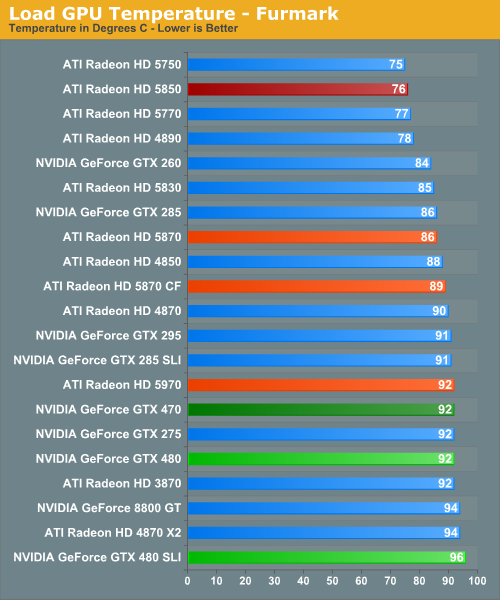
For our load temperatures, we have gone ahead and added Crysis to our temperature testing so that we can see both the worst-case temperatures of FurMark and a more normal gameplay temperature.
At this point the GTX 400 series is in a pretty exclusive club of hot cards – under Crysis the only other single-GPU card above 90C is the 3870, and the GTX 480 SLI is the hottest of any configuration we have tested. Even the dual-GPU cards don’t get quite this hot. In fact it’s quite interesting that unlike FurMark there’s quite a larger spread among card temperatures here, which only makes the GTX 400 series stand out more.
While we’re on the subject of temperatures, we should note that NVIDIA has changed the fan ramp-up behavior from the GTX 200 series. Rather than reacting immediately, the GTX 400 series fans have a ramp-up delay of a few seconds when responding to high temperatures, meaning you’ll actually see those cards get hotter than our sustained temperatures. This won’t have any significant impact on the card, but if you’re like us your eyes will pop out of your head at least once when you see a GTX 480 hitting 98C on FurMark.
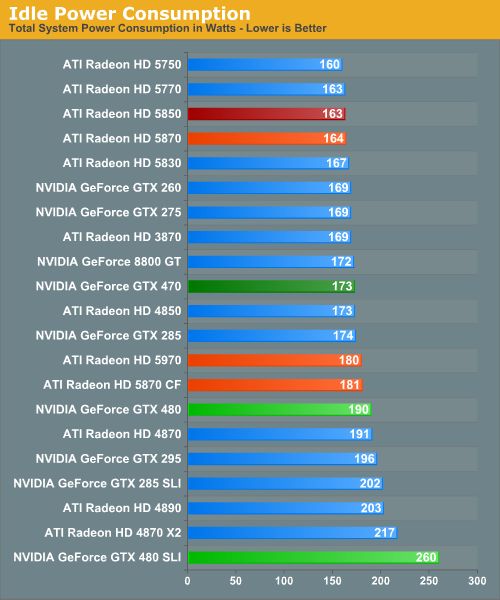
Up next is power consumption. As we’ve already discussed, the GTX 480 and GTX 470 have an idle power consumption of 47W and 33W respectively, putting them out of the running for the least power hungry of the high-end cards. Furthermore the 1200W PSU we switched to for this review has driven up our idle power load a bit, which serves to suppress some of the differences in idle power draw between cards.
With that said the GTX 200 series either does decently or poorly, depending on your point of view. The GTX 480 is below our poorly-idling Radeon 4000 series cards, but well above the 5000 series. Meanwhile the GTX 470 is in the middle of the pack, sharing space with most of the GTX 200 series. The lone outlier here is the GTX 480 SLI. AMD’s power saving mode for Crossfire cards means that the GTX 480 SLI is all alone at a total power draw of 260W when idle.
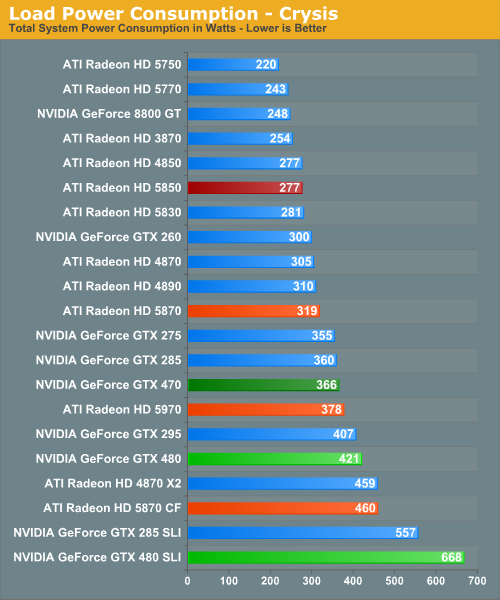
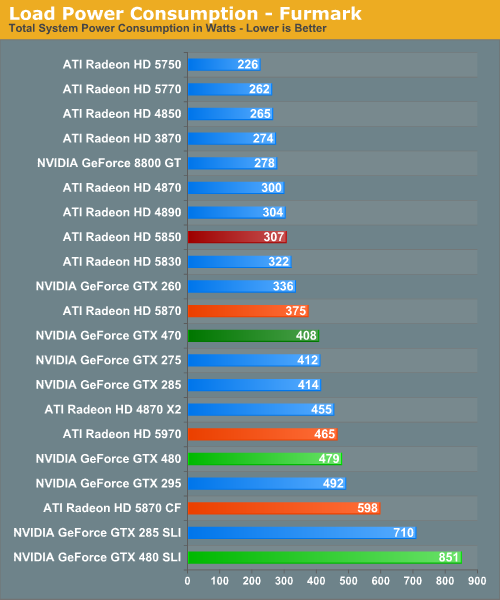
For load power we have Crysis and FurMark, the results of which are quite interesting. Under Crysis not only is the GTX 480 SLI the most demanding card setup as we would expect, but the GTX 480 itself isn’t too far behind. As a single-GPU card it pulls in more power than either the GTX 295 or the Radeon 5970, both of which are dual-GPU cards. Farther up the chart is the GTX 470, which is the 2nd most power draining of our single-GPU cards.
Under FurMark our results change ever so slightly. The GTX 480 manages to get under the GTX 295, while the GTX 470 falls in the middle of the GTX 200 series pack. A special mention goes out to the GTX 480 SLI here, which at 851W under load is the greatest power draw we have ever seen for a pair of GPUs.

Idle noise doesn’t contain any particular surprises since virtually every card can reduce its fan speed to near-silent levels and still stay cool enough. The GTX 400 series is within a few dB of our noise floor here.
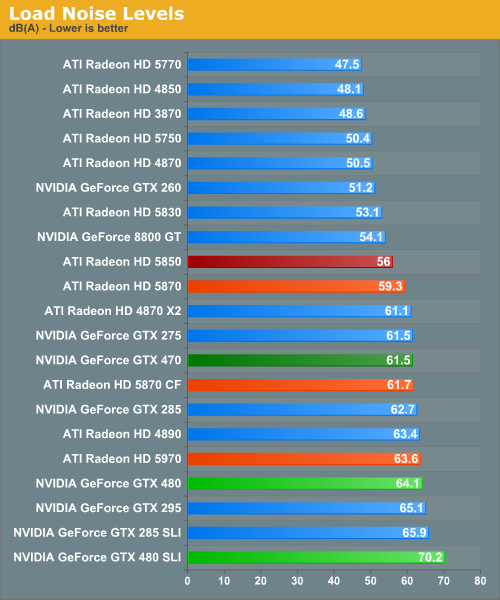
Hot, power hungry things are often loud things, and there are no disappointments here. At 70dB the GTX 480 SLI is the loudest card configuration we have ever tested, while at 64.1dB the GTX 480 is the loudest single-GPU card, beating out even our unreasonably loud 4890. Meanwhile the GTX 470 is in the middle of the pack at 61.5dB, coming in amidst some of our louder single-GPU cards and our dual-GPU cards.
Finally, with this data in hand we went to NVIDIA to ask about the longevity of their cards at these temperatures, as seeing the GTX 480 hitting 94C sustained in a game left us worried. In response NVIDIA told us that they have done significant testing of the cards at high temperatures to validate their longevity, and their models predict a lifetime of years even at temperatures approaching 105C (the throttle point for GF100). Furthermore as they note they have shipped other cards that run roughly this hot such as the GTX 295, and those cards have held up just fine.
At this point we don’t have any reason to doubt NVIDIA’s word on this matter, but with that said this wouldn’t discourage us from taking the appropriate precautions. Heat does impact longevity to some degree – we would strongly consider getting a lifetime warranty for the GTX 480 to hedge our bets.










196 Comments
View All Comments
deputc26 - Friday, March 26, 2010 - link
"GTX 480 only has 11% more memory bandwidth than the GTX 285, and the 15% less than the GTX 285."and holy server lag batman.
529th - Friday, March 26, 2010 - link
Thanks for the review :)ghost2code - Saturday, March 27, 2010 - link
I'm really impressed by this article author made a great job;) But about Fermi It's seem to be really good product for scientific matters but for gamers I'm not so sure about that. The price tag, power consumption, noise! this all is to much for only 10-15% of power more than above the cheaper and much more reasonable in all this things Radeon. I guess Fermi need some final touch from Nvidia and for now it's not a final , well tested product. Temp around 100 it's not good for PCB, GPU and all electronic and I don't believe it want metter for time-life and stability of the card. I'm glad the Farmi finally came but I'm dissapointed at least for now.LuxZg - Saturday, March 27, 2010 - link
I just don't know why GTX480 is compared to HD5870, and same for GTX470 vs HD5850.. GTX470 is right in the middle between two single-GPU Radeons, and just the same can be said for GTX480 sitting right in between HD5970 & HD5870.Prices of this cards as presented by nVidia/ATI:
HD5970 - 599$
GTX480 - 499$
HD5870 - 399$
GTX470 - 349$
HD5850 - 299$
I know GTX480 is single GPU, so by this logic you'll compare it to HD5870. But GTX480 is top of the line nVidia graphics card, and HD5970 is top of the line ATI card. Besides, ATI's strategy for last 3 product cycles is producing small(er) chips and go multi-GPU, while nVidia wants to go single-monolitic-GPU way.. So following this logic, indeed GTX480 should be compared to HD5970 rather than HD5870.
Anyway, conclusion of this article is all fine, telling both strengths and the weaknesses of solutions from both camps, but I believe readers weren't told straightforward enough that these cards don't cost the same... And HD5970 was left out of the most of the comparisions (textual ones).
If I personaly look at these cards, they are all worth their money. nVidia cards are probably more future-proof with their commitment to future tech (tessellation, GPGPU) but AMD cards are better for older and current (and close future) titles. And they are less hot, and less noisy, which most gamers do pay a lot of attention to. Not to say - this is first review of new card in which no one mentioned GPU overclocking. I'm guessing that 90+C temperatures won't allow much better clocks in the near future ;)
Wwhat - Sunday, March 28, 2010 - link
In regards to the temperature and noise: there's always watercooling to go to, I mean if you have so much money to throw at the latest card you might as well thrown in some watercooling too.It's too pricey for me though, I guess I'll wait for the 40nm process to be tweaked, spending so much money on a gfx card is silly if you know a while later something new will come around that's way better, and it's just not worth committing so much money to it in my view.
It's a good card though (when watercooled), nice stuff in it and faster on all fronts, but it also seems an early sample of new roads nvidia went into and I expect they will have much improved stuff later on (if still in business)
LuxZg - Tuesday, March 30, 2010 - link
Like I've said before - if you want FASTEST (and that's usually what you want if you have money to throw away), you'll be buying HD5970. Or you'll be buying HD5970+water cooling as well..ViRGE - Saturday, March 27, 2010 - link
I'm not sure where you're getting that the HD5970 is a $600 card. In the US at least, that's a $700 card (or more) everywhere.wicko - Sunday, March 28, 2010 - link
Honestly I don't even know if it should be mentioned at all even if it is 600, because there is almost no stock anywhere.LuxZg - Tuesday, March 30, 2010 - link
Oh, don't make me laugh, please! :D In that case this review shouldn't be up at all, or it should be called "PREview".. or have you actually seen any stock of GTX470/480 arround?LuxZg - Sunday, March 28, 2010 - link
It's AMD's & nVidia's recommended prices, and you can see them all in Anandtech's own articles:http://www.anandtech.com/video/showdoc.aspx?i=3783">http://www.anandtech.com/video/showdoc.aspx?i=3783 (nvidia prices)
http://www.anandtech.com/video/showdoc.aspx?i=3746">http://www.anandtech.com/video/showdoc.aspx?i=3746 (ATI single-gpu cards)
http://www.anandtech.com/video/showdoc.aspx?i=3679">http://www.anandtech.com/video/showdoc.aspx?i=3679 (ATI single/dual GPU cards)
It is not my fault that your US shops bumped up the price in the complete absence of competition in the high end market. But US is not only market in the world either.
You want to compare with real world prices? Here, prices from Croatia, Europe..
HD5970 - 4290kn = 591€ (recommended is 599$, which is usually 599€ in EU)
GTX480 - not listed, recommended is 499$/€
HD5870 - 2530kn = 348€ (recommended is 399$/399€ in EU)
GTX470 - not listed, recommended is 349$/€
HD5850 - 1867kn = 257€ (recommended is 299$/299€ in EU)
So let's say that European prices for GTX will be a bit lower than recommended ones, GTX480 would still be ~120-130€ pricier than HD5870, and HD5970 would be same ~120-130€ more expensive than GTX480.
As for the lower priced nVidia card, it's again firmly in the middle between HD5850 & HD5870.
Point is that there's no clear price comparision at the moment, and article's conclusion should be clear on that.
Person that wants the FASTEST CARD will stretch for another 100$/€ to buy HD5970. Especially since this means lower noise, lower consumption, and lower heat. This all combined means you can save a few $/€ on PSU, case, cooling, and earplugs, throwing HD5970 in the arm reach of the GTX480 (price-wise) while allowing for better speeds.
As for GTX470, again, lower consumption/heat/noise with ATI cards which means less expenses for PSU/cooling, and saving money on electrical bills. For me, well worth the 50€/$ difference in price, in fact, I'd rather spend 50$/€ more to buy HD5870 which is faster, less noisy, doesn't require me to buy new PSU (I own HD4890, which was overclocked for a while, so HD5870 would work fine just as well), and will save me 50W per hour of any game I play.. which will all make it CHEAPER than GTX470 in the long run.
So let's talk again - why isn't conclusion made a bit more straightforward for end users, and why is HD5890 completely gone from the conclusion??